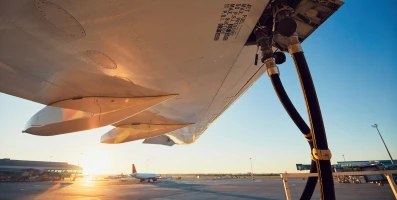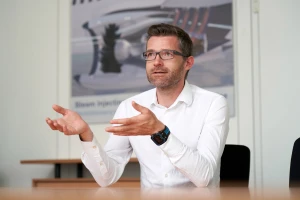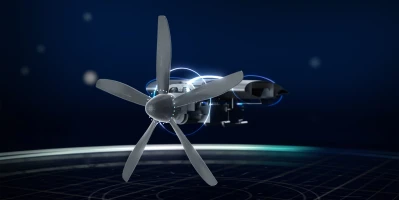aviation
How climate-friendly flight routes make air travel greener
In addition to further technical improvements to aircraft, climate-optimized flight routes and fuel-saving approach procedures will make air travel greener in the future.
author: Denis Dilba | 5 mins reading time published on: 10.11.2020
author:
Denis Dilba
holds a degree in mechatronics, is a graduate of the German School of Journalism, and founded the “Substanz” digital science magazine. He writes articles about a wide variety of technical and business themes.

Efforts to reorganize air travel to make it more climate-friendly have been well underway for a long time. More efficient engines, lighter composite materials and improved aerodynamics have been key to the considerable reduction in aircraft kerosene consumption over the past few decades. In turn, this successfully put the brakes on the rise in CO2 emissions caused by the sector’s continuous growth. And despite the current coronavirus crisis, the industry’s ambitious efforts to further cut emissions through improved designs continued unabated. However, even if technical upgrades could save still more fuel in the future, stakeholders all agree that a further improvement in the industry’s ecological footprint requires measures in other areas as well. For this reason, rather than looking solely at the technical side of air travel, focus has expanded in the past few years to include operational aspects: optimizing flight routes to limit their impact on the climate and improving air traffic management promise to play an auxiliary but significant role in more eco-friendly air travel. This approach should also minimize detours and holding patterns.
“A whole host of scientific studies over the past few years has shown that the impact aircraft emissions have on the climate is highly location-specific,” says Robert Sausen from the Institute of Atmospheric Physics at the German Aerospace Center (DLR) in Oberpfaffenhofen, Germany. “The basic idea behind climate-optimized flight routes is to fly around those areas of the atmosphere where emissions have a particularly strong impact on account of the predominating weather conditions,” he explains. Nowadays, flights are plotted to keep flight time to a minimum and consume as little kerosene as possible. Those measures have of course made considerable progress toward more efficient operation of aircraft and greener air traffic. Sausen, a pioneer in this research field, continues: “To proceed further, however, we have to shift the focus of our optimization efforts. CO2 emissions actually account for just about one-third of an aircraft’s total climate impact.”
“One to two percent of all persistent contrails, known as the ‘Big Hits,’ are responsible for more than 80 percent of warming. It makes sense to concentrate on these first.”
Avoiding persistent contrails
The remaining impact consists of the warming effect caused by persistent contrails (responsible for two-thirds) and ozone production as a consequence of nitrogen oxide emissions. Water vapor and soot particles emitted when kerosene is burned play a smaller role, Sausen says. “If you put all the factors together in a climate cost function that assigns a current value of overall climate impact to every location in the atmosphere, then you can work out which flight routes would have the least effect on the climate,” he explains. His calculations have shown that this approach can reduce climate impact by 20 percent—without making technical changes to aircraft. Sausen says that purely theoretically, this figure could go higher if aircraft also slowed down their air speed.
He estimates that it could take 10 to 15 years before air traffic managers start applying a comprehensive calculation of climate-optimized flight routes. One faster way to help—and one that doesn’t involve major intervention in the global air traffic system—would be to simply avoid areas where persistent contrails form. Contrails account for the lion’s share of the portion of non-CO2 emissions that impact the environment, Sausen says. However, it is not necessary to prevent all of them. “One to two percent of all persistent contrails, known as the ‘Big Hits,’ are responsible for more than 80 percent of warming. It makes sense to concentrate on these first,” Sausen says. Since the Big Hits form only in very cold, moist layers of air, which are often just a few hundred meters thick, all the aircraft has to do is fly a bit higher or lower to suppress their formation almost completely. Sausen believes no-fly zones for Big Hit areas or toll solutions may arrive in as few as five years from now.
Continuous descent saves kerosene
To reduce carbon dioxide emissions during landing, Deutsche Flugsicherung GmbH (DFS) has been working with airlines to further develop the continuous descent approach. Now, the aircraft begin their descent later. Landing simulations show that this can save up to 85 liters of kerosene per flight.
Continuous descents and freer choice of route
An adjustment in air traffic management is never simple, as Michael Finke, a researcher at the DLR Institute of Flight Guidance in Braunschweig, Germany, can attest. He coordinates the European-Chinese research project, Greener Air Traffic Operations (GreAT), which hopes to make flying more climate-friendly. Launched at the beginning of the year, the project’s goal is to limit CO2 emissions, a departure from Sausen’s climate cost function. This alone is already a key step toward eco-friendlier air travel. “Currently, detours and holding patterns are not rare occurrences,” Finke says. The reason is that a great many factors go into the planning of a flight route, some of which—say, maintaining the necessary airspace capacity—essentially hinder the minimizing of CO2 emissions. “For safety reasons, for example, the aircraft have to be staggered at various altitudes; however, each aircraft has only one altitude that is optimal for fuel consumption,” Finke continues. Another factor is the fees that accrue when flying through other countries’ airspace. As Finke puts it: “Airlines save money by flying around more expensive countries, but doing so creates more CO2 emissions.”
“Optimizing air traffic management is a step toward sustainable aircraft operations. However, this is just one piece of the puzzle, not a complete solution for achieving eco-friendly air travel. We have to keep on with our work and research on all fronts.”
One promising idea the GreAT researchers are looking into has already been around for a while: the continuous descent approach, or CDA. “This is where the aircraft goes directly from its cruising altitude to its descent, maintaining a constant angle until landing,” Finke explains. This saves fuel compared to conventional descents. However, there’s a catch: since every aircraft has its own vertical flight profile, the distancing regulations currently in force would initially lead to losses in capacity. “Our task includes investigating how we can broadly apply CDAs without incurring these losses,” Finke says. As for long-haul flights, the part of GreAT for which the Chinese partners are responsible, expanding the flexibility of route selection could open up options for shorter routes. “At the moment, this is possible in only a few countries. In other parts of the world, there are stricter provisions in place regarding flight routes,” Finke says. “It could lead to some massive improvements if routes could be selected freely around the world.”
Overall, Finke explains, we have to keep an eye on the big picture: “Optimizing air traffic management is a step toward sustainable aircraft operations. However, this is just one piece of the puzzle, not a complete solution for achieving eco-friendly air travel. We have to keep on with our work and research on all fronts.”







